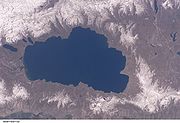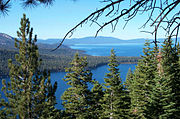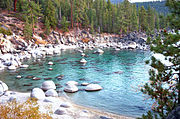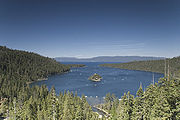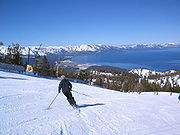
Lake Tahoe
About this schools Wikipedia selection
This selection is made for schools by a children's charity read more. With SOS Children you can choose to sponsor children in over a hundred countries
| Lake Tahoe | |
|---|---|
| Location | California, Nevada |
| Coordinates | 39°1′N 120°1′W |
| Lake type | Geologic block faulting |
| Primary outflows | Truckee River |
| Basin countries | United States |
|
|
|
| Max. length | 22 mi (35 km) |
| Max. width | 12 mi (19 km) |
| Surface area | 191 sq mi (490 km2) |
| Average depth | 989 ft (301 m) |
| Max. depth | 1,645 ft (501 m) |
| Water volume | 122,160,280 acre·ft (150.68249 km3) |
| Residence time | 650 years |
| Shore length1 | 71 mi (114 km) |
| Surface elevation | 6,229 ft (1,899 m) |
|
|
|
| Islands | Fannette Island |
| Settlements | South Lake Tahoe CA, Stateline NV, Tahoe City CA |
| 1 Shore length is not a well-defined measure. | |
Lake Tahoe is a large freshwater lake in the Sierra Nevada mountains of the United States. It is located along the border between California and Nevada, west of Carson City, Nevada. Lake Tahoe is the largest alpine lake in the United States. Its depth is 514 m making it America's second-deepest. The lake is known for the clarity of its water and the panorama of surrounding mountains on all sides.
The area surrounding the lake is also referred to as Lake Tahoe, or simply Tahoe. It is home to a number of ski resorts, summer outdoor recreation, and tourist attractions.
Geography
Lake Tahoe is the second deepest lake in the United States, with a maximum depth of 1,645 feet (501 m), trailing only Oregon's Crater Lake at 1,949 ft (594 m). Tahoe is also the 16th deepest lake in the world, and the fifth deepest in average depth. It is about 22 mi (35 km) long and 12 mi (19 km) wide and has 72 mi (116 km) of shoreline and a surface area of 191 square miles (495 km²).
Approximately two-thirds of the shoreline is in California. The south shore is dominated by the lake's largest city, South Lake Tahoe, California, which adjoins the town of Stateline, Nevada, while Tahoe City, California is located on the lake's northwest shore. Although highways run within sight of the lake shore for much of Tahoe's perimeter, many important parts of the shoreline now lie within state parks or are protected by the United States Forest Service.
Natural history
Geology
The Lake Tahoe Basin was formed by a geologic block (normal) faulting about 2 million years ago. A geologic block fault is a fracture in the earth's crust causing blocks of land to move up or down. Uplifted blocks created the Carson Range on the east and the Sierra Nevada on the west. Down-dropped blocks (a graben) created the Lake Tahoe Basin in between.
More technically, Lake Tahoe is the youngest of several extensional basins of the Walker Lane Deformation Belt that accommodates nearly 12 mm/yr of dextral shear between the Sierra Nevada Microplate and North America. The Tahoe basin is formed by a series of large down-to-the-east normal faults, including the West Tahoe—Dollar Point fault, Stateline/North Tahoe fault and the Incline Village fault. These right-stepping en-echelon faults are capable of large magnitude 7 earthquakes, with the most recent M7 paleoquake (~1500 AD) occurring on the Incline Village fault with nearly 3 m of vertical offset
Some of the highest peaks of the Lake Tahoe Basin that formed during process of Lake Tahoe creation are Freel Peak at 10,891 ft (3,320 m), Monument Peak at 10,067 ft (3,068 m) (the present Heavenly Ski Resort), Pyramid Peak at 9,983 ft (3,043 m) (in the Desolation Wilderness), and Mount Tallac at 9,735 ft (2,967 m).
Eruptions from the extinct volcano Mount Pluto formed a dam on the north side. Melting snow filled the southern and lowest part of the basin to form the ancestral Lake Tahoe. Rain and runoff added additional water.
Modern Lake Tahoe was shaped and landscaped by scouring glaciers during the Ice Ages, which began a million or more years ago. Many streams flow into Lake Tahoe, but the lake is drained only by the Truckee River, which flows northeast through Reno, Nevada and into Pyramid Lake, Nevada which has no outlet.
Soils of the basin come primarily from andesitic volcanic rocks and granodiorite, with minor areas of metamorphic rock. Some of the valley bottoms and lower hill slopes are mantled with glacial moraines, or glacial outwash material derived from the parent rock. Cryopsamments, Cryumbrepts, rockland, rock outcrops and rubble and stony colluvium account for over 70% of the land area in the basin (see USA soil taxonomy). The basin soils (in the < 2 mm fraction) are generally 65-85% sand (0.05–2.0 mm).
Given the great depth of Lake Tahoe, and the locations of the normal faults within the deepest portions of the lake, modeling suggests that earthquakes on these faults can trigger tsunamis. Wave heights of these tsunamis are predicted to be on the order of 3 to 10 m in height, capable of traversing the lake in just a few minutes. A massive collapse of the western edge of the basin that formed McKinney Bay around 50,000 years ago is thought to have generated tsunami/ seiche wave with height approaching 100 m.
Climate
Mean annual precipitation ranges from over 55 inches (1400 mm) in watersheds on the west side of the basin to about 26 inches (660 mm) near the lake on the east side of the basin. Most of the precipitation falls as snow between November and April, although rainstorms combined with rapid snowmelt account for the largest floods. There is a pronounced annual runoff of snowmelt in late spring and early summer, the timing of which varies from year to year. In some years, summertime monsoon storms from the Great Basin bring intense rainfall, especially to high elevations on the east side of the basin.
The National Weather Service reports that August is normally the warmest month at the Tahoe Valley Airport (elevation 6,254 ft/1,906 m) with an average maximum of 78.7 °F (29.5 °C) and an average minimum of 39.8 °F (4.3 °C). January is the coolest month with an average maximum of 41.0 °F (5.0 °C) and an average minimum of 15.1 °F (-9.4 °C). The all-time maximum of 99 °F (37.2 °C) was recorded on July 22, 1988. The all-time minimum of -29 °F (-33.9 °C) was recorded on December 9, 1972, and February 7, 1989. Temperatures exceed 90 °F (32.2 °C) on an average of 2.0 days annually. Minimum temperatures of 32 °F (0 °C) or lower occur on an average of 231.8 days annually, and minimum temperatures of 0 °F (-17.8°C) or lower occur on an average of 7.6 days annually. Freezing temperatures have occurred every month of the year. No precipitation statistics are available for the airport.
Ecology
Vegetation in the basin is dominated by a mixed conifer forest of Jeffrey pine (P. Jeffreyi), lodgepole pine (P. contorta), white fir (Abies concolor), and red fir (A. magnifica). The basin also contains significant areas of wet meadows and riparian areas, dry meadows, brush fields (with Arctostaphylos and Ceanothus) and rock outcrop areas, especially at higher elevations. Ceanothus is capable of fixing nitrogen, but mountain alder (Alnus tenuifolia), which grows along many of the basin’s streams, springs and seeps, fixes far greater quantities, and contributes measurably to nitrate-N concentrations in some small streams.
Human history
Native peoples
The area around Lake Tahoe was originally inhabited by the Washoe tribe of Native Americans. Lake Tahoe was the centre and heart of Washoe Indian territory, including the upper valleys of the Walker, Carson, and Truckee Rivers. The English name for lake Tahoe derives from the Washo dá’aw, "lake".
Exploration
Lt. John C. Frémont and Kit Carson were the first non-indigenous people to see Lake Tahoe, during Fremont's second exploratory expedition. John Calhoun Johnson, Sierra explorer and founder of "Johnson's Cutoff" (now Hwy 50), was the first white man to see Meeks Bay and from a peak above the lake he named " Fallen Leaf Lake, California" after his Indian guide. His first job in the west was in the government service, carrying the mail on snowshoes from Placerville to Nevada City, during which time he named the lake "Lake Bigler" in honour of California’s governor John Bigler. In 1853 William Eddy, the surveyor general of California, identified Tahoe as Lake Bigler. In 1862 the U.S. Department of the Interior first introduced the name Tahoe. Both names were used until well into the next century. The lake didn't receive its official and final designation as Lake Tahoe until 1945.
California and Nevada reached the compromise to partition Tahoe between the two when California became a state. With the state line through the middle of the lake and then at 39 degrees north latitude, the state border runs southeasterly towards the Colorado River.
Mining era
Upon discovery of gold in the South Fork of the American River in 1848, thousands of gold seekers going west passed near the basin on their way to the gold fields. European civilization first made its mark in the Lake Tahoe basin with the 1858 discovery of the Comstock Lode, a silver deposit just 15 miles (24 km) to the east in Virginia City, Nevada. From 1858 until about 1890, logging in the basin supplied large timbers to shore up the underground workings of the Comstock mines. The logging was so extensive that loggers cut down almost all of the native forest. In 1864, Tahoe City was founded as a resort community for Virginia City, the first recognition of the basin’s potential as a destination resort area.
Development
Public appreciation of the Tahoe basin grew, and during the 1912, 1913, and 1918 congressional sessions, congressmen tried unsuccessfully to designate the basin as a national park. During the first half of the 20th century, development around the lake consisted of a few vacation homes. The post-World War II population and building boom, followed by construction of gambling casinos in the Nevada part of the basin during the mid-1950s, and completion of the interstate highway links for the 1960 Squaw Valley Olympics, resulted in a dramatic increase in development within the basin. From 1960 to 1980, the permanent residential population increased from about 10,000 to greater than 50,000, and the summer population grew from about 10,000 to about 90,000. Since the 1980s, development has slowed due to controls on land use.
Government and Politics
Lake Tahoe lies within the borders of both California and Nevada, and as such is not governed by any single entity. In California, Lake Tahoe is divided between Placer County and El Dorado County. In Nevada, Lake Tahoe is divided among Washoe County, Douglas County and Carson City (an independent city).
The Tahoe Regional Planning Agency (TRPA) is a federal regulatory agency which is charged with environmental protection of the Lake Tahoe Basin through land-use regulation and planning.
As an interstate waterway, Lake Tahoe is subject to the United States Coast Guard (USCG).
Environmental issues
Water quality
In spite of land-use planning and export of treated sewage effluent from the basin, the lake is becoming increasingly eutrophic (having an excessive richness of nutrients), with primary productivity increasing by more than 5% annually, and clarity decreasing at an average rate of 0.25 meters per year. Fine sediment, much of it resulting from land disturbance in the basin, accounts for about half of the loss in clarity. Charles Goldman from UC Davis was directly responsible for prompting Tahoe officials to pump all sewage effluent from the basin when Tahoe was being greatly developed in the 1950s. Goldman made local officials understand that even treated sewage would greatly affect the water quality of Lake Tahoe.
Until the early 1980s, nutrient-limitation studies showed that primary productivity in the lake was nitrogen-limited. Now, after a half-century of accelerated nitrogen input (much of it from direct atmospheric deposition), the lake is phosphorus-limited. Because the volume of the lake is so large (156 km³) and its hydraulic residence time so long (about 650 years), its eutrophication may be essentially irreversible.
Lake Tahoe never freezes. Since 1970, it has mixed to a depth of at least 400 m a total of 6 or 7 times. Dissolved oxygen is relatively high from top to bottom.
Analysis of the temperature records in Lake Tahoe has shown that the lake warmed (between 1969 and 2002) at an average rate of 0.015 °C per year. The warming is caused primarily by increasing air temperatures, and secondarily by increasing downward long-wave radiation. The warming trend is reducing the frequency of deep mixing in the lake, and may have important effects on water clarity and nutrient cycling.
Ecosystem changes
Since the 1960s, the Lake's food web and zooplankton populations have undergone major changes. In 1963–65, opossum shrimp ( Mysis relicta) were introduced to enhance the food supply for the introduced Kokanee salmon (Onchorhynchus nerka). The shrimp began feeding on the Lake's cladocerans (Daphnia and Bosmina), and their populations virtually disappeared by 1971. The shrimp provide a food resource for salmon and trout, but also compete with juvenile fish for zooplankton. Since the 1970s, the cladoceran populations have somewhat recovered, but not to former levels.
Lake Tahoe is actually a tributary watershed drainage element within the Truckee River Basin, and its sole outlet is the Truckee River, which continues on to discharge to Pyramid Lake. Because of the sensitivity of Truckee River water quality (involving two protected species, the cui-ui sucker fish and the Lahontan cutthroat trout), this drainage basin has been studied extensively. The primary investigations were stimulated by the U.S. Environmental Protection Agency, who funded the development of the DSSAM model to analyze water quality below Lake Tahoe.
In June 2007, the Angora Fire burned approximately 3,100 acres (13 km²) throughout the South Lake Tahoe area. While the impact of ash on the lake's ecosystem is predicted to be minimal, the impact of potential future erosion is not yet known.
Environmental protection
Until recently, construction on the banks of the Lake had been largely under the control of wealthy real estate developers. Construction activities have resulted in a clouding of the lake's blue waters. Currently, the Tahoe Regional Planning Agency is regulating construction along the shoreline (and has won two Federal Supreme Court battles over recent decisions). These regulations are unpopular with many residents, especially those in the Tahoe Lakefront Homeowners Association.
The League to Save Lake Tahoe (Keep Tahoe Blue) has been the public interest watchdog in the Lake Tahoe Basin for 50 years. Founded when a proposal to build a four-lane highway around the lake—with a bridge over the entrance to Emerald Bay—was proposed in 1957, the League has repeatedly thwarted poorly designed development projects and environmentally unsound planning. Currently evaluating the "Pathways 2007" comprehensive plan being developed by TRPA, the League embraces responsible and diversified use of the Lake's resources while protecting and restoring its natural attributes.
Since 1980, the Lake Tahoe Interagency Monitoring Program (LTIMP) has been measuring stream discharge and concentrations of nutrients and sediment in up to 10 tributary streams in the Lake Tahoe Basin, California-Nevada. The objectives of the LTIMP are to acquire and disseminate the water quality information necessary to support science-based environmental planning and decision making in the basin. The LTIMP is a cooperative program with support from 12 federal and state agencies with interests in the Tahoe Basin. This data set, together with more recently acquired data on urban runoff water quality, is being used by the Lahontan Regional Water Quality Control Board to develop a program (mandated by the Clean Water Act) to limit the flux of nutrients and fine sediment to the Lake.
Tourist activities
Much of the area surrounding Lake Tahoe is devoted to the tourism industry and there are many restaurants, ski slopes and casinos catering to visitors.
Winter sports
During ski season, thousands of people from all over Nevada and California, including Las Vegas, Los Angeles San Diego and San Francisco, flock to the slopes for some of the best skiing in the world. Lake Tahoe, in addition to its panoramic beauty, is well known for its blizzards.
Some of the major ski areas in Tahoe include:
- Heavenly Mountain Resort: the largest ski area in California and Nevada, located near Stateline, Nevada
- Squaw Valley: the second largest ski area, known for its hosting of the 1960 Winter Olympics, located near Tahoe City
- Alpine Meadows: a medium sized ski area on the north shore only a few miles from Squaw Valley
- Diamond Peak: a small ski area located in Incline Village, Nevada
- Northstar at Tahoe: a popular north shore ski area
- Kirkwood Mountain Resort: a south shore ski area which gets more snow than any other ski area in Tahoe
- Sierra-at-Tahoe: a small south shore ski area
- Boreal Mountain Resort: a small ski area on Donner Pass
- Sugar Bowl Ski Resort: a medium sized ski area in Donner Pass
- Donner Ski Ranch: a very small ski area on Donner Pass
- Homewood Ski Resort: a medium sized ski area on the west shore
- Mount Rose Ski Resort: a medium sized ski area north-east of the Lake, on Slide Mountain
The majority of the ski resorts in the Lake Tahoe region are on the northern end of the lake, near Truckee, California and Reno, Nevada. Kirkwood, Sierra-at-Tahoe and Heavenly are located on the southern side of the lake, approximately 80 miles (129 km) from Reno. It is common for visitors to ski amongst these 3 resorts when staying in Southern Lake Tahoe and not venture to the northern lake resorts ( Squaw Valley, Northstar at Tahoe, Sugar Bowl, etc.).
For an instant overview of the locations and conditions of Tahoe ski resorts, see Ski Bonk's resort map.
Scattered throughout Tahoe are public and private sled parks. Some, such as Granlibakken are equipped with rope tows to help sledders get up the hill.
Many ski areas in Tahoe also have Snow tubing, such as Squaw Valley. Snow tubing is popular among people who are interested in alternative sports. Throughout Tahoe, Cross Country Skiing, Snowmobile riding, and Snowshoeing are also popular, thus there are many trails for them.
Water sports
During late Spring to early Fall, the lake is popular for water sports and beach activities. The two cities most identified with the Lake Tahoe tourist area are South Lake Tahoe, California and the smaller Stateline, Nevada; smaller centers on the northern shoreline include Tahoe City and Kings Beach.
Boating, the primary activity in Tahoe in the summer, is known worldwide. There are lakefront restaurants all over the lake, most equipped with docks and buoys (See the restaurants section) There are all sorts of boating events, such as sailboat racing, firework shows over the lake, guided cruises, and more. Lake Tahoe also has its own Coast Guard.
Hiking and mountain biking
There are hundreds of hiking and mountain biking trails all around the lake. They range in length, difficulty, and popularity. One of the most famous of Tahoe's trails is the Tahoe Rim Trail, a 165 mile (270 km) trail that circumnavigates the lake. Directly to the west of the lake is the Granite Chief Wilderness, which provides great hiking and wilderness camping. Also, to the southwest is the very popular Desolation Wilderness. One of the most popular trailheads is the Eagle Lake Trailhead.
Highways
Visitors can reach Lake Tahoe in 2 hours from the Sacramento area via U.S. Route 50. In winter months, chains or snow tires are sometimes necessary, particularly from the communities of Twin Bridges to Meyers which is on the other side of the Sierra Nevada. Highway 50 passes the Lake Tahoe Airport en route to shoreline communities and eventually Stateline, Nevada. The Pioneer Trail is an effective bypass for reaching the popular casinos at Stateline and the Heavenly Mountain Resort, after which it re-connects with Highway 50. After following the eastern shoreline northbound through Zephyr Cove and Glenbrook, it heads sharply east over the Carson Range and down into the valley towards Carson City, Nevada.
The other primary route to Lake Tahoe is on Interstate 80 that goes over Donner Pass and through Truckee and then on to Reno. Once in Truckee one can take highway 267 or Highway 89 to Kings Beach or Tahoe City, respectively, on the north shore of the lake. Unlike U.S. Route 50 which is a 2 lane highway through the Sierra Nevada, Interstate 80 is a 4 lane highway.
Highway 89 splits off before South Lake Tahoe at an intersection known as "The Y." It crosses the western edge of the lake through the picturesque wilderness and connects camping, fishing and hiking locations such as those at Emerald Bay State Park, DL Bliss State Park and Camp Richardson. Farther along are communities such as Meeks Bay and Tahoe City. Finally, the highway turns away from the lake and heads northwest toward Truckee.
Highway 28 completes the circuit from Tahoe City up and around the northern shore to communities such as Kings Beach, Crystal Bay, and into Incline Village, Nevada. Both a California and Nevada State Highway, Route 28 returns along the eastern shore to meet up with US Highway 50 near Spooner Lake.
Other roads include State Route 431, which connects to Reno, Nevada, from the north shore. Drivers from the south shore would take U.S. Route 50 to Carson City and then head north on U.S. Route 395 into Reno. State Route 207, also known as the Kingsbury Grade, heads over the Carson Range and into Carson Valley communities beyond.
Peaks and mountains
|
|
|

